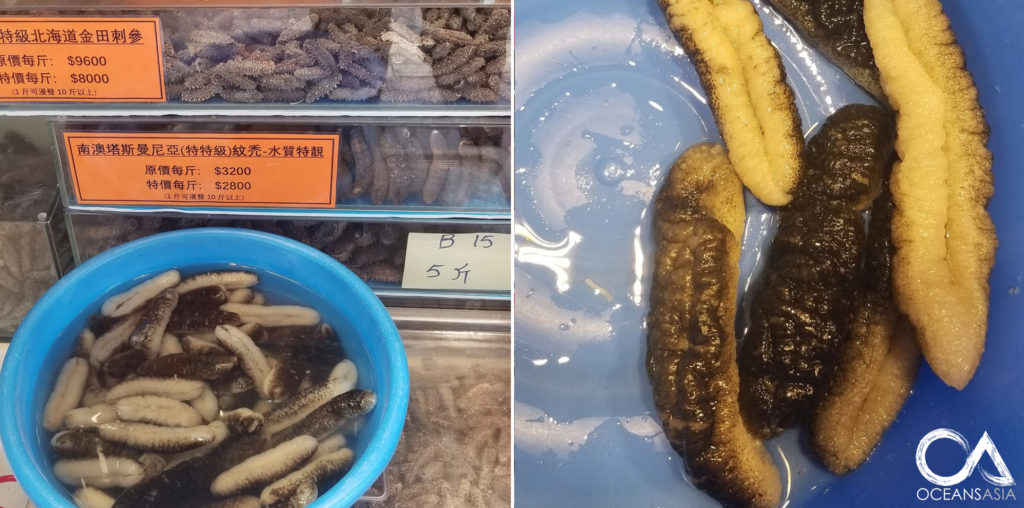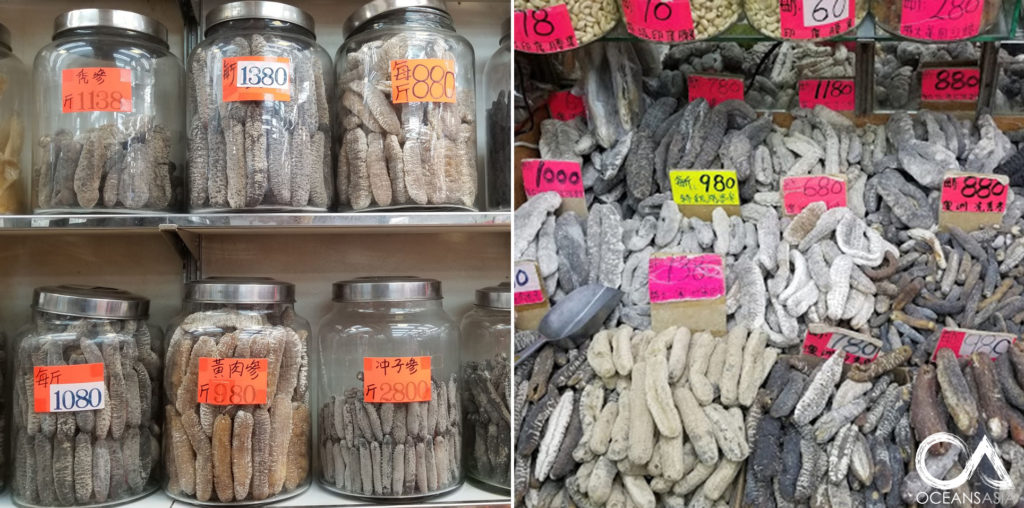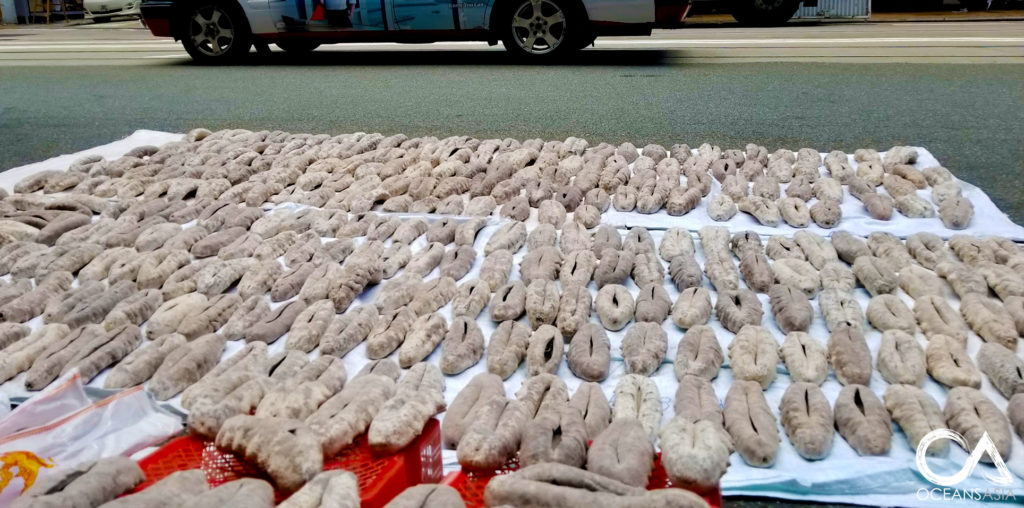Why Sea Cucumbers?

Why Sea Cucumbers?
By Dr Teale Phelps Bondaroff
In the conservation movement, we are often focused on high-profile charismatic species. While protecting animals like whales, sharks, dolphins and their habitats is important, this sometimes leads to lesser-known species falling by the wayside.
At OceansAsia, we are dedicated to marine conservation and have been working on issues relating to sharks, dolphins, and whales, but we also recognize the importance of protecting all marine creatures, as they all play a critical role in marine ecosystems.
For the past several months, we have been engaged in a detailed study of the sea cucumber fisheries supply chain. We have been examining all available literature on sea cucumbers, seeking to gain a better understanding of these fascinating animals, and to identify crime throughout this fishery.
When I tell people about sea cucumbers and my research – and I do this constantly – I am often asked why this species, why sea cucumbers? I wanted to take a moment to offer some insight into this question, get people excited for our upcoming sea cucumber report, and make a case for investigating and tackling crime in the fisheries of lesser-known marine species.

Sea cucumbers play a vital role in marine ecosystems
Many species of sea cucumber burrow in the sea bed, and this action is a major source of bioturbation, which allows other species to flourish on the seabed. As deposit feeders, sea cucumbers play an important role in nutrient cycling. Their actions reduce organic loads and redistribute surface sediment, and the inorganic nitrogen and phosphorus they excrete enhances the benthic habitat. In this way, they make excellent bioremediators. These same actions increase seawater alkalinity, which helps create local buffers against ocean acidification, supporting the survival of coral reefs. Sea cucumbers are food for others species, and also have complex symbiotic relationships with others.
As one study concluded: “Overexploitation of sea cucumbers is likely to decrease sediment health, reduce nutrient recycling and potential benefits of deposit-feeding to seawater chemistry, diminish biodiversity of associated symbionts, and reduce the transfer of organic matter from detritus to higher trophic levels.” Those interested in learning more about the many ecological roles of commercial exploited sea cucumbers will find “Ecological Roles of Exploited Sea Cucumbers” and “Serial Exploitation of Global Sea Cucumber Fisheries” informative.
It is often smaller, less charismatic species that play vital roles like these in ecosystems. Take for example krill, which is a keystone species at the centre of the Southern Oceans food web. These ecosystem services help keep these habitats healthy for all species.
Ultimately all species deserve protection, and in the triage that we as conservationists must ultimately conduct, we mustn’t neglect species like the sea cucumber.

Overlapping supply chains and investigative efficacy
Trafficking in wildlife products is big business. As awareness of an illicit supply chain emerges, states and conservationists take measures to combat this trade. While these efforts are critical, the more effective the measures, the more countermeasures criminals adopt to protect their lucrative business. The complex methods used by wildlife traffickers to conceal such things as caviar or fins from endangered shark species, increases the difficulty of detecting and ultimately breaking these illicit supply chains.
While we should not stop these efforts, investigating adjacent supply chains can prove highly effective. Illegal wildlife products are often part of complex criminal barter trade networks. One well-documented example is that of poached abalone in South Africa, which is involved in a triangular trade for guns and methamphetamine precursors.
Likewise, the supply chain used to transport one illegal product is often used to transport others, and sometimes illicit products are even transported together. The same lax or ineffective enforcement that allows illegal fishing to flourish also misses people and smuggling activities using the same vessels. For example, drug cartels in the Caribbean have moved into smuggling highly lucrative totoaba swim bladders, using their pre-existing transport systems. Smuggling fish bladders, whose value often far exceeds that of illegal drugs, is both more lucrative and less dangerous – The resources dedicated to combating wildlife crime are smaller, and the punishments meted out on those caught are lighter than those associated with drug smuggling.
Those interested in learning more about the relationships between organized crime and illegal fishing should read “The Illegal Fishing and Organized Crime Nexus.”

Protecting ‘replacement’ species
Unfortunately, demand for some wildlife products is driving certain species to extinction, and when this occurs, rather than collapsing, demand will often shift to a similar ‘replacement’ species. An example of this can be seen in the market for high value swim bladders. The highest value swim bladders, prized for their size and thickness, are those of the Chinese bahaba, a yellow croaker also known as the yellow-lip fish. Demand for these swim bladders, known as the ‘golden maw’ drove up prices, such that the last bahaba caught was sold for a staggering $473,000 USD. Such was the value of the swim bladder of this fish that it now critically endangered and commercially extinction.
Swim bladders from this species were replaced by those from the totoaba, a croaker found in the Gulf of California, in Mexico. Demand for these fish are not only pushing this species to the brink of extinction but also killing critical endangered vaquita porpoises. When these species becomes commercially extinct, the market will shift, and either target another croaker species, like the Nile perch, or shift to another luxury fish product, like sea cucumbers.
We must be proactive if we want to stay one step ahead of criminal enterprises. By investigating future replacement species, we can help establish procedures to protect these animals before voracious serial exploitative markets ‘discover’ them. In this way, our work investigating crime in the sea cucumber fisheries supply chain will not only protect these important marine animals, but other species and ecosystems as well.

